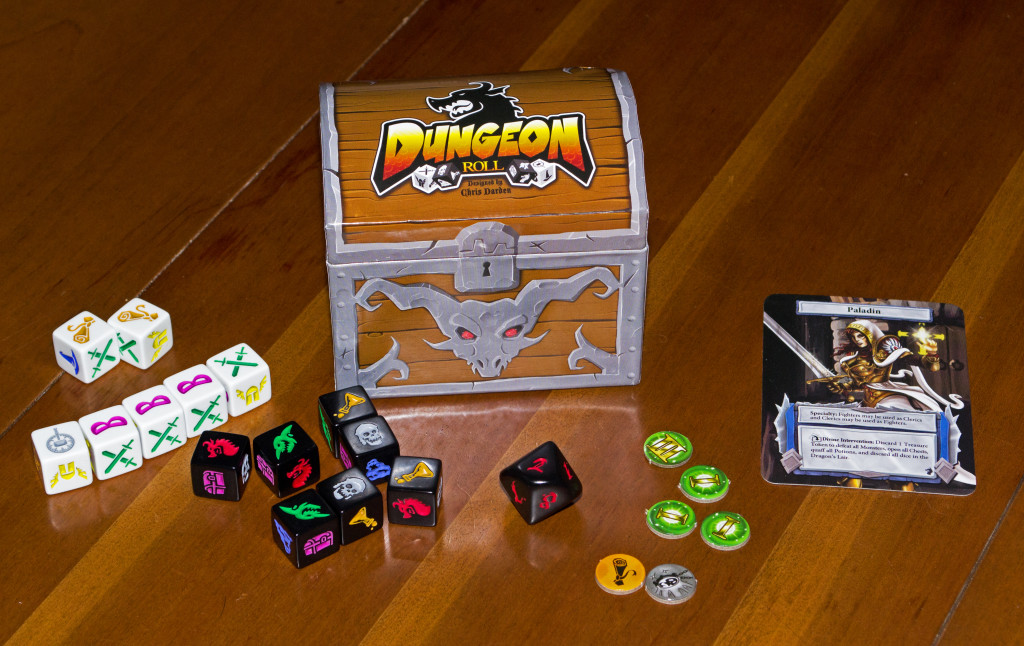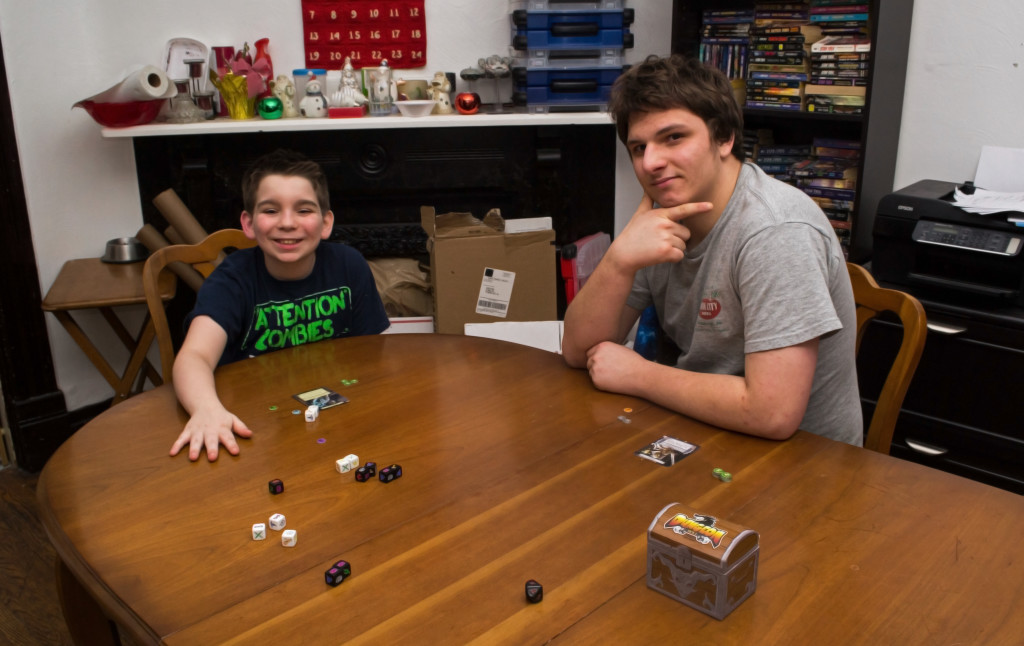Fancy a quick dungeon delve without having to spend days creating a character? “Dungeon Roll” will give you the opportunity to form a party as quickly as you can roll a set of dice, a concept that busy parents everywhere can appreciate. Each player will form a party, delve into a dungeon as deeply as they think they can go without having to flee, and compare their experience after three rounds to see who is the best adventurer among them. It sounds simple (and it partially is), but you’ll need a good bit of luck and skill to escape the dangers you’ll face unscathed.
Components
Box/Chest – The box itself doubles as a chest that holds all of the loot players can draw from throughout the game.
Dice – There are 7 white party dice and seven black dungeon dice. The white party dice list champions, fighters, clerics, mages, thieves, and scrolls on their faces while the black dungeon dice contain goblins, skeletons, oozes, chests, potions, and dragons. There’s also a black experience die numbered 1-10.
Tokens – There are experience and treasure tokens, the former of which helps players keep track of their “score” while the latter can be used to either help players delve or bank experience at the end of the game.
Hero Cards – Players will assume the role of one hero at the beginning of the game. Each hero has a different ability. A separate book of heroes is available should players want to learn more about what each hero can do.
Setup & Gameplay
Players choose (or randomly deal themselves) a hero card with the novice side showing. The experience tokens and dice are placed off to the side while the treasure tokens remain in the chest. The starting player (the one who was most recently underground) receives the white party dice. The player to the starting player’s left becomes the Dungeon Lord and receives the blank dungeon dice.
A typical turn plays out as follows:
1. The adventurer rolls all seven white/party dice to form their starting party. If the hero is exhausted from a previous round (by using their special ability), the card can be “untapped” to refresh it. The experience die is placed on the “1”.
2. Monster Phase: The Dungeon Lord rolls the number of black dungeon dice equal to the number showing on the experience die. The adventurer must fight and defeat these dice or flee…doing the latter will result in the player losing all experience earned on this delve.
3. Loot Phase: After defeating the monsters, the adventurer may open any chests or quaff any potions listed on the black dice (both are optional).
4. Dragon Phase: If three or more dragons have accumulated in the dragon’s lair (an imaginary space off to the side), the adventurer must defeat it (or get around it) before going any further. A player needs three different companions on their white party dice (tokens can be used) in order to defeat it. They earn a treasure and an experience point if they do so. Some treasures and abilities allow you to bypass the dragon, but no treasure or experience is earned with these options.
5. Regroup Phase: The Dungeon Lord will return any black dungeon dice to the available pool while the adventurer will decide if he/she will continue (“seek glory”). If they do, the experience die increases in value by one and the monster phase begins again. Any dice used to dispatch monsters, deal with the dragon, or open chests/quaff potions are not given back to the adventurer…that is, they’ll have to use what they have if they wish to press on.
When a delve is over (either the adventurer decides to leave or is forced to flee), both sets of dice are passed to their left. The game ends after three rounds (when each player has had three delves) and the person with the most accumulated experience, wins the game!
Editor’s Note: The above doesn’t cover all of the rules found in the manual, but should give you an idea as to how the game is played.
The Review
I honestly wasn’t expecting a lot out of this game when I first eyed it on the “Barnes and Noble” shelf. The box itself just looked flimsy and after unwrapping it from the plastic, I confirmed that it wouldn’t hold up from a lot of abuse. I would have honestly gone for something a bit more durable, though I do appreciate the design and theme behind it. Once you get passed the rather disappointing window dressing, you’ll realize just how much meat the game actually has. It’s a bit like “Zombie Dice”, but pushed to the next level.
While there is a lot of luck in how the dungeon dice roll, there’s an equal emphasis on how you use your party dice to deal with the bad rolls that may come up…and trust me, they will. Since your companions are each good at dispatching a particular monster, you’ll have to think a bit as to which dice you’ll want to give up at that particular moment (once a party die is used for any task, it is discarded). You might have two champions, a thief, and a warrior in your party for example, and be presented with two chests. Your first instinct would be to use the thief to open both (warriors, clerics, and mages can only open one), but you realize that you have two dragon dice sitting in the lair and there’s a good chance you’ll be facing off against it soon. Giving up a champion to open both will still leave you with the three different companion types you’d need to defeat it.
The above situation is but one example of the choices you’ll be faced with in this game. Sometimes you may opt to have a scroll drink a potion in order to revive a champion (you can make the party die anything you want) and others, you may decide to keep the scroll in the event you get a bad roll (three monsters of different types). Tokens score you experience points at the game’s end, so sometimes it’s best to bow out early on a delve in order to save them. Then again, one token might be all you need to go two more levels. Each character also has a special ability, which can be upgraded (by flipping the card over after earning so much experience) and used to get yourself out of some nasty situations. There’s no shortage of “if-then” dilemmas here.
Despite the poor presentation, I found “Dungeon Roll” to be a joy to play. It packs a bigger punch than “Zombie Dice”, I feel, and I honestly can’t wait to get back in there to see how well I can do the next time around. Twenty bucks was a fair price to pay in retrospect, though I do think fifteen would have been more realistic.
Final Verdict: 7/10
—


